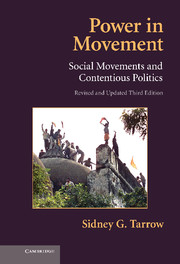Book contents
- Frontmatter
- Contents
- List of Figures
- List of Tables
- Preface
- Acknowledgments
- Introduction
- 1 Contentious Politics and Social Movements
- PART I THE BIRTH OF THE MODERN SOCIAL MOVEMENT
- PART II POWERS IN MOVEMENT
- PART III DYNAMICS OF CONTENTION
- 9 Mechanisms and Processes of Contention
- 10 Cycles of Contention
- 11 Struggling to Reform
- 12 Transnational Contention
- Conclusions: The Future of Social Movements
- Sources
- Index
- Titles in the series
12 - Transnational Contention
Published online by Cambridge University Press: 05 June 2012
- Frontmatter
- Contents
- List of Figures
- List of Tables
- Preface
- Acknowledgments
- Introduction
- 1 Contentious Politics and Social Movements
- PART I THE BIRTH OF THE MODERN SOCIAL MOVEMENT
- PART II POWERS IN MOVEMENT
- PART III DYNAMICS OF CONTENTION
- 9 Mechanisms and Processes of Contention
- 10 Cycles of Contention
- 11 Struggling to Reform
- 12 Transnational Contention
- Conclusions: The Future of Social Movements
- Sources
- Index
- Titles in the series
Summary
“In January 1997,” write Donatella della Porta and Manuela Caiani, Italian dairy farmers asked the Italian government to suspend collecting fines for the European Union (EU) related to “irregularities” allegedly committed by their organizations (della Porta and Caiani 2009: 37). The dairymen were accused of claiming they processed more milk products than Italy's dairy herds were capable of producing. But this was not their only reaction to the EU's fines:
Similar to many European farmers (Bush and Simi 2001), they protested against their own government though the source of their complaint was the EU.
Their protest campaign led them to create a new and decentralized organization.
They framed a new identity around a broad social agenda.
They joined an Italian farmers' protest in Brussels, bringing along a living symbol of their profession – “Caroline the Cow.”
And they came into contact with farmers from other European countries and joined them in protests against the World Trade Organization (p. 40).
Why begin a discussion of transnational contention with the story of a minor dairymen's protest against their own government's failure to defend their interests? More than a decade ago, it appeared to many that globalization and a growing movement against it were eroding the hegemony of the state system (Clark 2003; Florini 2003; Kaldor 2003; McMichael 1996). Scholars, nongovernmental advocacy organization (NGO) advocates, social movement activists, and enthusiastic young people joined worldwide protests against neo-liberalism behind the hopeful slogan “Another World is Possible.”
- Type
- Chapter
- Information
- Power in MovementSocial Movements and Contentious Politics, pp. 234 - 258Publisher: Cambridge University PressPrint publication year: 2011
- 1
- Cited by



